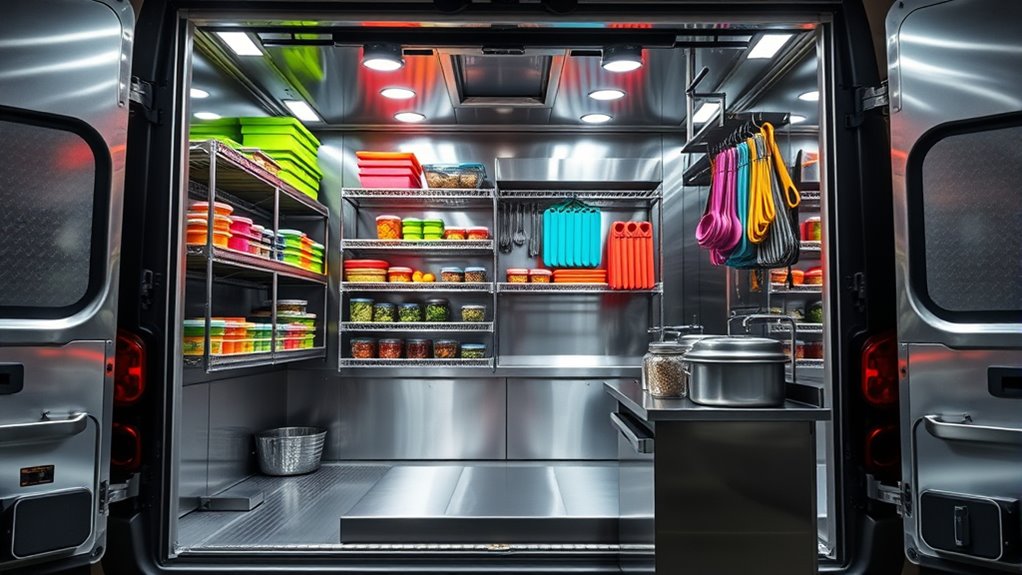To set up efficient food truck storage, choose a vehicle with tall ceilings, flat floors, and multiple access points to maximize space. Use vertical and modular shelves, adjustable containers, and hanging racks to keep everything organized and accessible. Incorporate specialized refrigeration and cold storage for food safety, while practice proper waste management and safety standards. If you’re interested in more tips to optimize your setup, there’s plenty more to explore below.
Key Takeaways
- Choose a vehicle with tall ceilings, flat floors, and multiple access points for optimal storage and easy loading.
- Incorporate modular, adjustable shelving and vertical storage solutions to maximize interior space.
- Plan the layout to include dedicated zones for dry, cold, and frozen storage, ensuring quick access and food safety.
- Install efficient refrigeration units with precise temperature control, and regularly monitor for compliance and product quality.
- Implement organized waste management with clearly labeled bins and accessible disposal stations to maintain hygiene and safety.
Optimizing Vehicle Selection for Storage Efficiency
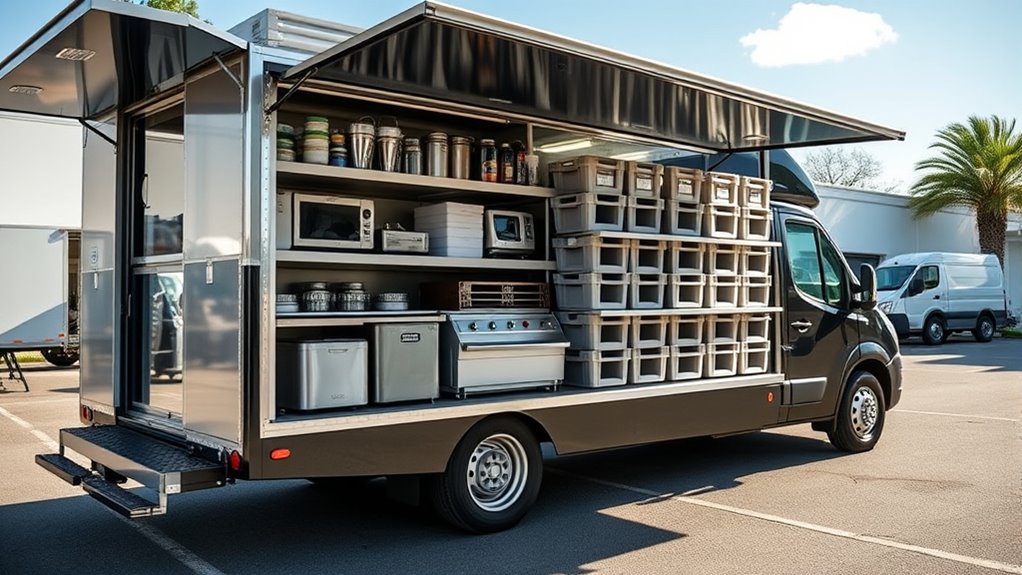
Choosing the right vehicle is essential for maximizing storage efficiency in a food truck. You need a size that balances mobility and capacity—larger trucks offer more storage but can be harder to maneuver. Opt for models like box trucks or step vans with tall ceilings to utilize vertical space effectively. Flat floors with minimal wheel well intrusion make installing storage systems easier. Multiple access points, such as side and rear doors, simplify loading and unloading. Look for vehicles that support custom shelving, pull-out drawers, and overhead racks to make the most of interior space. Ensure they can accommodate built-in refrigeration and modular storage units, allowing you to adapt as your menu evolves. Prioritize lightweight materials and proper weight management to maintain stability and fuel efficiency. Additionally, understanding nutrient deficiencies in vegan diets can help you plan nutritious meals that require efficient storage of fresh produce and supplements.
Designing a Functional Kitchen Layout
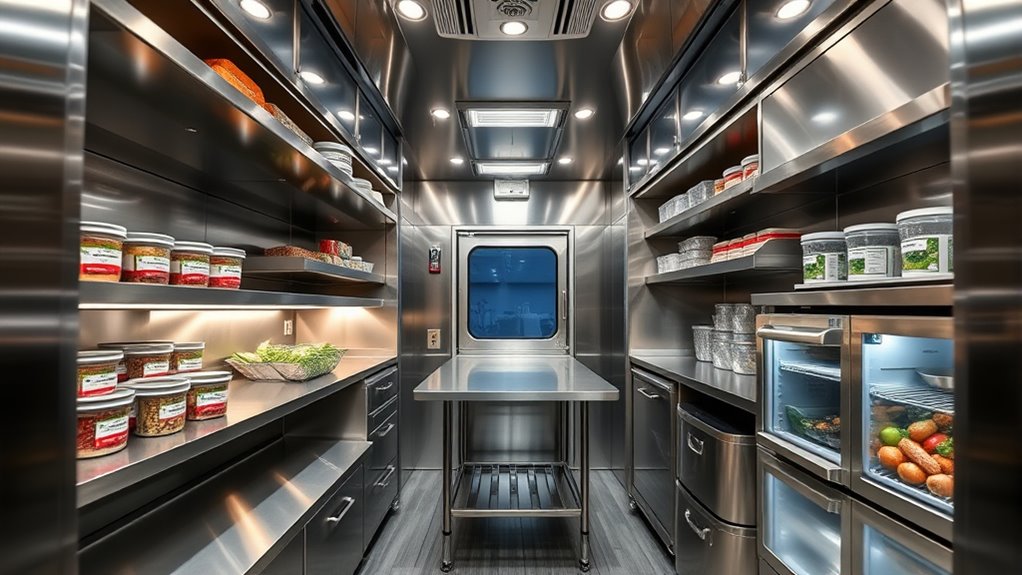
Designing a functional kitchen layout begins with a clear understanding of your menu, as this shapes the entire workspace to support efficient food preparation and cooking processes. Your menu determines the ideal equipment placement and work zones, ensuring smooth workflow and minimizing unnecessary movement. Focus on creating a logical flow from prep to cooking to service, using the kitchen work triangle to connect key areas seamlessly. Proper zoning separates hot and cold tasks, reducing cross-contamination and bottlenecks. Consider space-saving configurations like U-shape or galley layouts to maximize efficiency within limited space. Keep safety and ergonomics in mind, positioning equipment for natural motions and safe clearance. A well-designed layout boosts productivity, enhances safety, and creates a comfortable environment for your crew to thrive. Effective layout planning ensures optimal use of limited space, which is crucial for small food trucks. Additionally, incorporating workflow optimization techniques can further streamline operations and reduce turnaround times.
Implementing Vertical and Modular Storage Solutions
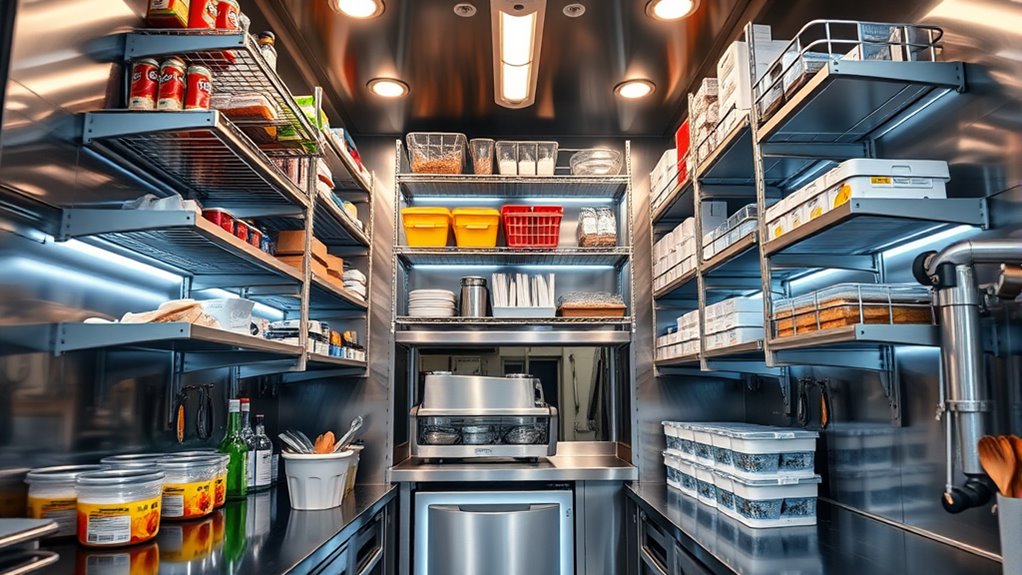
To make the most of your food truck’s limited space, consider implementing vertical storage solutions like ceiling-mounted cabinets and wall racks. Modular options, such as stackable containers and customizable shelving, can adapt to changing menu needs and workflow. These strategies help you maximize storage capacity while keeping your workspace organized and efficient. Efficient organization methods are essential to prevent clutter and ensure quick access to supplies during busy hours. Additionally, understanding city dynamics can assist in designing storage solutions that comply with local regulations and optimize workflow in your specific environment.
Maximize Vertical Space
Maximizing vertical space in a food truck involves installing effective storage solutions that make use of wall and ceiling areas. Vertical shelving utilizes often-unused wall space, freeing up countertops and floors for prep and cooking. Metal or stainless-steel shelves resist heat and moisture, meeting health standards, while adjustable shelves allow customization based on container sizes. Installing shelves above workstations keeps tools and ingredients within arm’s reach, speeding up prep. Hanging storage solutions, like racks and magnetic strips, optimize space by storing pots, pans, knives, and small tools vertically. Ceiling-mounted rails and hooks keep lightweight items off the floor. Properly mounted, these solutions boost safety, improve organization, and create a more efficient workflow—making every inch count in your mobile kitchen. Incorporating water-resistant materials into shelving and storage areas further enhances durability in the humid environment of a food truck.
Modular Storage Flexibility
Implementing modular storage solutions in your food truck offers unmatched flexibility to adapt your space to changing needs. With interchangeable components like lockable drawers, cabinets, and shelves, you can customize your setup for various inventory types and equipment. Heavy-duty steel guarantees durability during transport and daily use. Modular systems let you combine different-sized units to maximize space utilization in tight quarters. Stackable racks and containers save floor space and improve organization, while specialized units like drum racks hold large containers securely. These flexible solutions can be reconfigured or relocated quickly, accommodating seasonal changes or inventory fluctuations. Lockable compartments enhance safety, and stable stacking prevents accidents. Additionally, incorporating space-efficient storage techniques can further optimize your limited area. Overall, modular storage boosts efficiency, keeps your workspace tidy, and extends the lifespan of your supplies. Heavy-duty steel construction provides a long-lasting solution that withstands the rigors of daily operations.
Efficient Use of Refrigeration and Cold Storage

To keep your food safe and fresh, you need to set your refrigeration units to ideal temperatures and regularly monitor them. Organizing your cold storage helps speed up access and reduces temperature fluctuations. By combining precise temperature control with a well-structured storage system, you can maximize efficiency and maintain food quality during busy hours. Proper temperature management is essential to prevent spoilage and ensure compliance with food safety standards. Additionally, implementing Kia Tuning principles such as customized systems can enhance the reliability of refrigeration units, minimizing downtime and maintaining consistent performance.
Optimal Temperature Settings
Maintaining the correct temperature in your food truck’s refrigeration units is essential for food safety and quality. Keeping perishables between 32°F and 40°F slows bacterial growth and preserves freshness. For dairy, set between 34°F and 38°F; for fresh produce, 35°F to 40°F; and raw meats at 32°F to 36°F. Frozen items should be at -18°C, with ice cream requiring -25°C. Use multi-zone units to separate different food types, and pre-cool compartments before loading. Precise temperature control ensures FDA compliance and product integrity for perishable freight. Regularly monitoring and adjusting temperatures based on ambient conditions helps prevent spoilage and maintain optimal storage conditions. Feel confident knowing your food stays safe and fresh. Protect your reputation by avoiding spoilage. Save money with energy-efficient, precise cooling. Ensure regulatory compliance and customer trust. Adjust thermostat settings based on ambient conditions, and regularly calibrate your monitoring tools. Maintaining proper temperatures is crucial for quality, safety, and peace of mind during every shift.
Organized Storage Systems
Maximizing storage efficiency in your food truck starts with choosing the right refrigeration setup. Multi-temperature units allow you to store perishable items at different temperatures, optimizing space and ensuring food safety. These modular systems eliminate the need for custom compartments and support transporting both fresh and frozen foods simultaneously. Autonomous battery-powered containers provide portability and continuous cooling without relying on vehicle power. To make the most of your space, consider combining various units like undercounter refrigerators, reach-in units, and prep tables, which can be arranged for maximum efficiency. Implementing climate control strategies can further enhance the preservation and quality of stored items.
Managing Inventory With Smart Organization Techniques
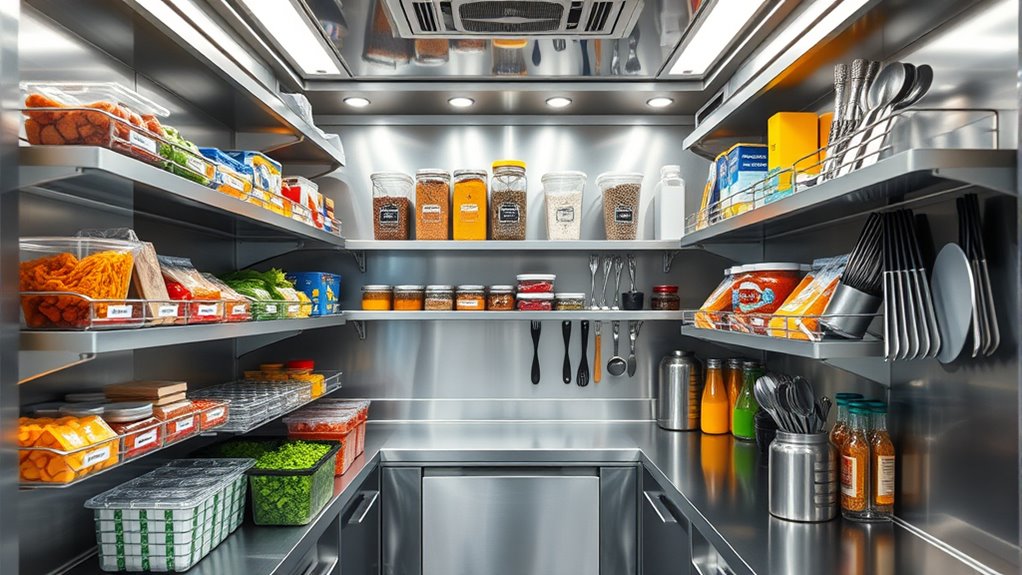
Effective inventory management is essential for food trucks to stay efficient and reduce waste, especially given their limited space. By using smart organization techniques, you can stay on top of stock levels and streamline operations. Implement technology-driven systems like POS software tailored for food trucks to track sales and inventory in real-time. Automate reordering and spoilage tracking to prevent shortages and spoilage. Categorize ingredients by type and usage frequency, storing them in labeled containers for quick access. Conduct daily inventory checks to adjust stock based on demand. Use analytics to identify slow-moving items, helping you make better purchasing decisions. Leveraging integrated POS solutions can further enhance inventory accuracy and operational oversight.
- Feel confident knowing your inventory is organized and under control
- Experience less stress during busy service hours
- Save money by minimizing waste and overstocking
- Keep your truck running smoothly and efficiently
Incorporating Waste Management Systems
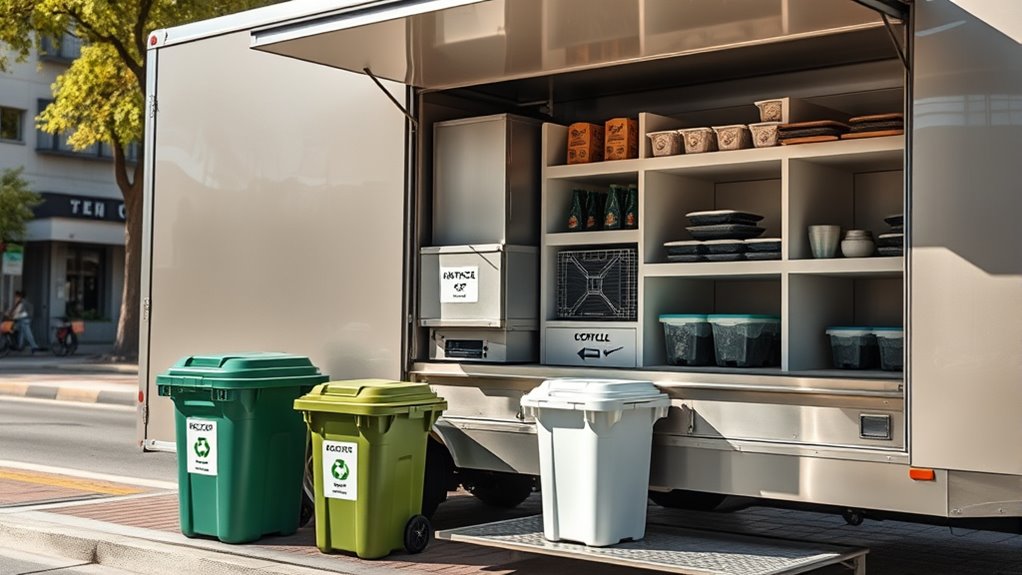
Implementing effective waste management starts with clear segregation strategies to sort organic, recyclable, and waste materials properly. Compact disposal solutions help save space and streamline cleanup, while regular maintenance keeps your system running smoothly. By staying on top of these practices, you can guarantee compliance and reduce environmental impact. Proper waste segregation is essential for maximizing recycling efforts and minimizing landfill contributions. Additionally, using reusable materials wherever possible can significantly decrease waste generation and promote sustainability.
Waste Segregation Strategies
Have you considered how proper waste segregation can streamline your food truck’s operations and boost sustainability? Clear, labeled bins inside your truck for organic waste, recyclables, landfill waste, and compostables make source separation simple and efficient. Color-coded containers help staff and customers sort waste accurately, especially during busy times. Placing waste stations at service points encourages immediate disposal and reduces mess. Use leak-proof, odor-control bins for wet waste to maintain hygiene and prevent pests. Strategically positioning bins ensures quick access without disrupting workflow. Proper waste segregation can also improve overall sanitation and reduce odors within your truck, making the environment safer for staff and customers. Implementing an effective waste management system helps track waste volumes and optimize disposal schedules. Feel confident knowing your waste is properly sorted and managed. Reduce environmental impact by diverting waste from landfills. Simplify cleanup, saving time and effort. Demonstrate your commitment to sustainability and eco-friendliness.
Compact Disposal Solutions
Building on waste segregation strategies, integrating compact disposal solutions can optimize space and streamline waste management on your food truck. Use multi-stream bins for organics, recyclables, and landfill waste, designed to fit limited space while maintaining easy access. Secure lids help control odors and pests, ensuring a cleaner environment. Position bins strategically to improve workflow and reduce handling time. Regularly empty containers to prevent overfilling and sanitation issues. For grease and wastewater, install leak-proof tanks with secure caps and valves, and partner with local facilities for proper disposal. Incorporate compostable packaging and cleaning wipes into organic waste streams to simplify sorting. These compact disposal solutions help you maintain efficiency, comply with regulations, and reduce environmental impact—all within the limited space of your food truck. Proper waste disposal methods are essential for maintaining a clean and compliant operation.
Regular Maintenance Practices
Regular maintenance practices are essential for keeping waste management systems effective and hygienic on your food truck. Consistently cleaning and sanitizing surfaces prevents contamination and pest issues. Empty waste bins frequently to avoid odors and bacteria buildup. Schedule deep cleaning for refrigerators, grills, and exhaust systems to keep everything in top shape. Proper staff training on hygiene and cleaning checklists ensures standards are maintained. To make this easier, consider these key points:
- Stay on top of daily sanitation to prevent health hazards
- Use approved, food-safe cleaning agents for peace of mind
- Partner with local recycling programs for eco-friendly waste disposal
- Keep detailed logs to track cleanliness, waste, and maintenance for compliance
Implementing these practices helps ensure your food truck remains safe, clean, and ready to serve.
Additionally, maintaining a comprehensive maintenance schedule ensures that all equipment functions properly and reduces unexpected breakdowns.
Selecting Energy-Efficient Equipment
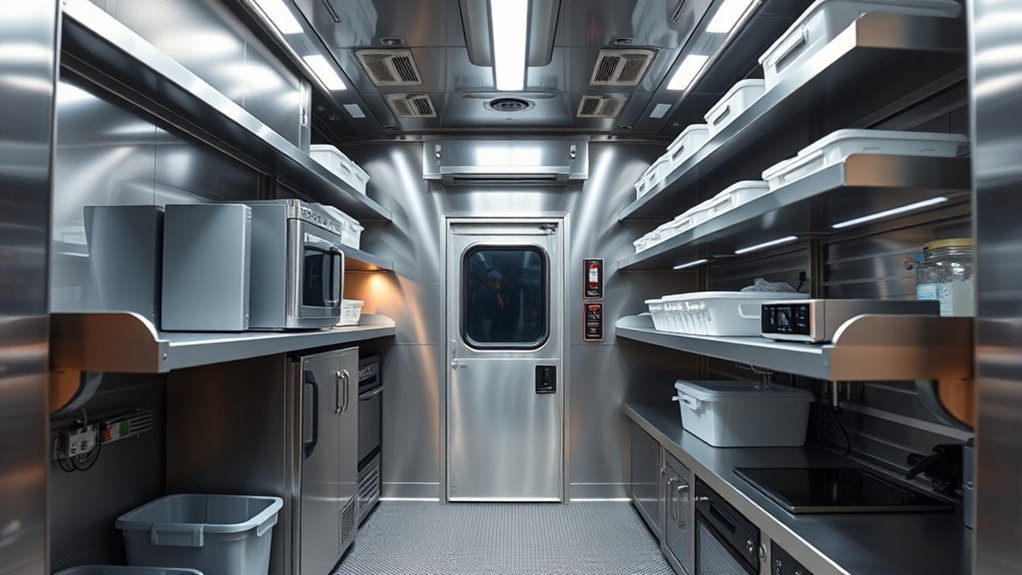
Choosing energy-efficient equipment is essential for maximizing your food truck’s performance while minimizing operating costs. ENERGY STAR certified refrigerators and freezers are up to 20% more efficient than standard models, reducing electricity bills. Proper insulation in refrigeration units helps maintain consistent temperatures, cutting energy waste. Opt for compact, dual-purpose units to save space and lower overall energy demand. Use temperature controls to optimize compressor cycles and prevent unnecessary energy use. Regularly maintaining seals and coils keeps refrigeration running efficiently. For cooking, ENERGY STAR-rated fryers consume about 30% less energy, while insulated appliances retain heat better. Induction cooktops heat faster and use less power than traditional stoves. Adding energy-efficient appliances can also extend their lifespan, saving money on replacements over time. These choices collectively reduce your energy footprint and improve overall efficiency.
Ensuring Compliance With Safety and Regulatory Standards
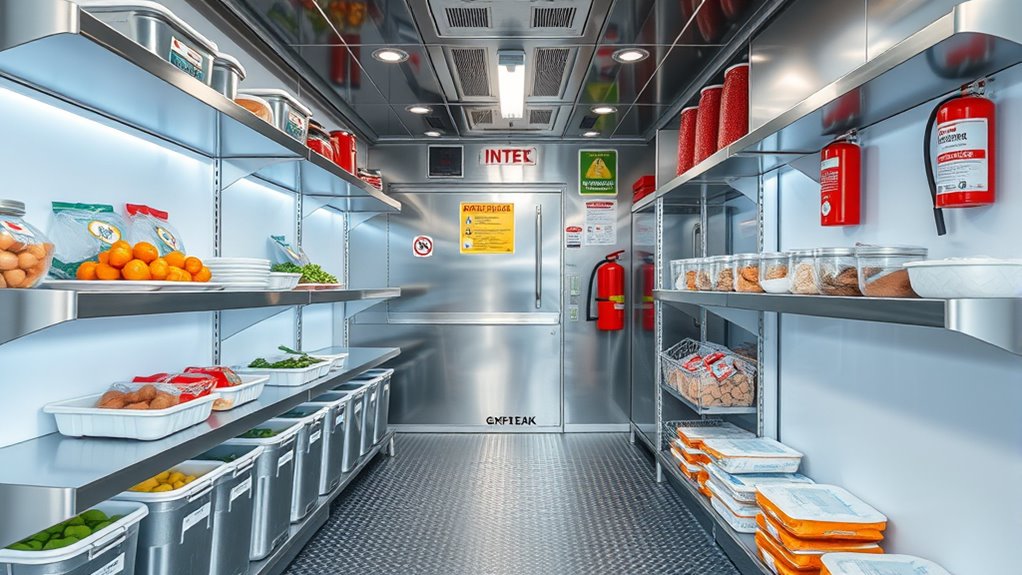
Ensuring compliance with safety and regulatory standards is vital for the legal operation and safety of your food truck. You must use durable, easy-to-clean materials for storage areas, keep food at safe temperatures, and prevent contamination. Proper waste management is essential—liquid waste tanks must be leak-proof and properly sized, while solid waste needs covered containment. Storage spaces should protect food from dirt, leaks, and temperature fluctuations, with food kept at least 6 inches above the floor. Regularly monitor temperatures with thermometers, and guarantee all surfaces are food-safe. Additionally, maintain clear documentation such as agreements with off-site facilities, safety certifications, and inspection records. These steps keep your operation compliant and help protect your customers and your business.
Adapting Storage for Diverse Menu Offerings
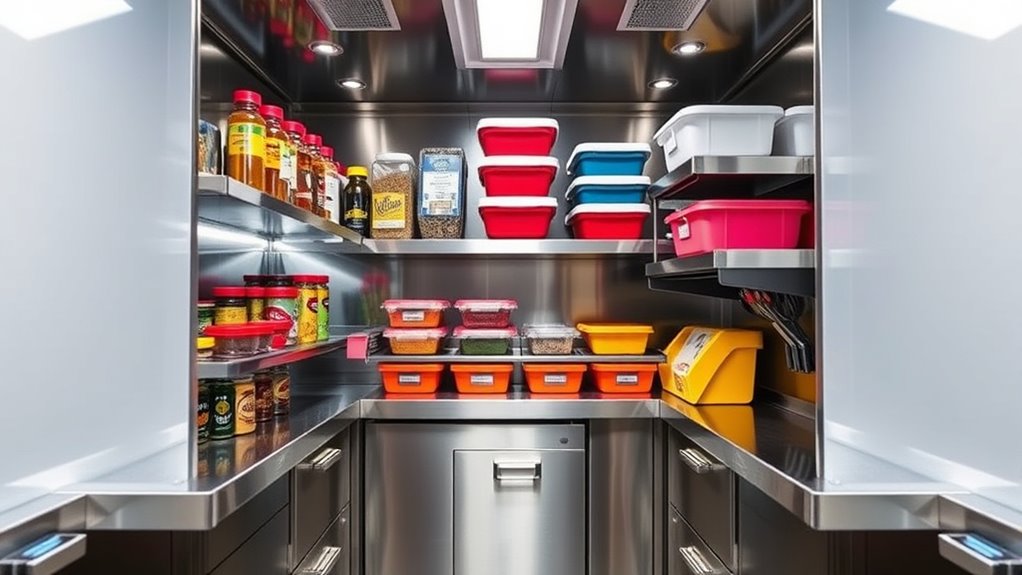
Adapting your storage setup to accommodate a diverse menu requires strategic organization and flexibility. You’ll need distinct cold and hot storage zones to keep ingredients safe and streamline workflow, as shown below:
| Cold Storage | Hot Storage |
|---|---|
| Refrigerated vegetables, dairy | Cooked foods, hot ingredients |
| Flexible prep stations | Ready-to-serve items |
| Airtight containers | Cross-contamination prevention |
Use modular shelving and stackable containers for easy adjustments based on ingredient quantities. Mobile storage units provide extra space for seasonal or bulk ingredients. Position dry storage near cooking areas to reduce retrieval time. Incorporate specialized racks for equipment and designate storage for supplies like disposables. This setup ensures quick access, minimizes clutter, and supports a menu that varies daily.
Leveraging Digital Tools for Inventory Tracking
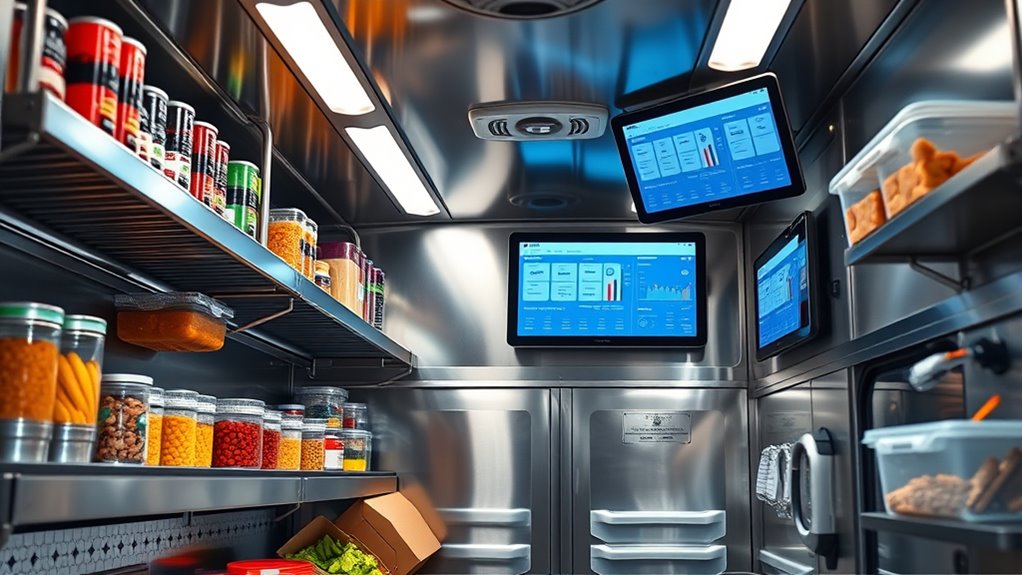
Leveraging digital tools for inventory tracking transforms how food trucks manage their supplies, enabling real-time monitoring of stock levels and streamlining operations. With automated alerts, you can prevent overstocking or shortages, reducing food waste and missed sales. Integration with POS systems links sales directly to inventory, giving you precise ingredient usage data. Spoilage tracking helps minimize losses from expired products, keeping your stock fresh. Analytics provide insights into demand patterns, costs, and inventory turnover, empowering smarter decisions. Efficient POS systems are crucial for smooth operations and cash flow, supporting optimized customer experiences and streamlined business management. Feel confident in always knowing your stock levels, avoiding surprises. Save time with automated reordering that keeps your supplies flowing. Minimize waste and maximize profits through precise spoilage alerts. Make informed choices with detailed sales and inventory insights.

Frequently Asked Questions
How Can I Maximize Storage Space Within a Limited Vehicle Footprint?
To maximize storage space within your vehicle, you should utilize vertical space by installing ceiling-mounted racks and hooks on walls for utensils. Choose multi-purpose, modular equipment that can be easily reconfigured, and install pull-out shelves or drawers inside cabinets to access items easily. Use inside cabinet doors for hanging tools, and plan your workflow carefully to keep essential tools nearby, ensuring everything is accessible without cluttering limited space.
What Are the Best Practices for Organizing Ingredients for Quick Access?
To organize ingredients for quick access, you should group items by usage zones, like storing proteins near cooking stations and produce close to prep areas. Use labeled containers or color-coded bins for easy identification, and keep frequently used ingredients at eye level. Maintain a FIFO system to rotate stock and reduce waste, and keep small tools nearby with magnetic strips or drawers. This setup streamlines workflow and speeds up service.
How Do I Balance Equipment Power Needs With Energy Efficiency?
Balancing equipment power needs with energy efficiency is like tuning a fine instrument—you want harmony without overextending. You should select energy-efficient appliances that meet your power requirements, avoiding unnecessary energy drain. Use thermostats and timers to optimize usage, and consider renewable energy options like solar. Oversize your generator just enough for future growth, but don’t go overboard. This approach keeps your truck running smoothly while conserving energy and reducing costs.
What Safety Considerations Are Essential for Food Storage in Small Trucks?
You need to prioritize safety by maintaining proper temperature controls, keeping cold foods at or below 41°F, and hot foods hot to prevent bacteria growth. Store raw and cooked foods separately to avoid cross-contamination, use calibrated thermometers, and make certain sanitation protocols are followed. Regularly disinfect surfaces, wash hands, and manage waste properly. Always comply with health regulations, keep detailed records, and train staff on food safety practices to protect both your customers and your business.
How Can Modular Storage Adapt to Menu Changes and Growth?
Did you know that flexible storage systems can increase your truck’s efficiency by up to 30%? You can adapt to menu changes and growth by using modular units with adjustable shelves, stackable containers, and mobile features. Reconfiguring your setup is quick, allowing you to expand or contract storage based on seasonal needs or menu innovations. This flexibility keeps your workflow smooth and supports your business’s evolving demands without costly overhauls.
Conclusion
By carefully optimizing your food truck storage, you create a well-oiled machine that runs smoothly, like a symphony. Embrace smart design, energy efficiency, and digital tools to keep everything organized and compliant. When your storage system flows seamlessly, it’s easier to serve fresh, delicious food without chaos or waste. Remember, a well-planned storage space isn’t just a necessity—it’s the backbone of your success on wheels.
